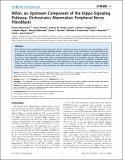Willin, an upstream component of the Hippo signaling pathway, orchestrates mammalian peripheral nerve fibroblasts
Abstract
Willin/FRMD6 was first identified in the rat sciatic nerve, which is composed of neurons, Schwann cells, and fibroblasts. Willin is an upstream component of the Hippo signaling pathway, which results in the inactivation of the transcriptional coactivator YAP through Ser127 phosphorylation. This in turn suppresses the expression of genes involved in cell growth, proliferation and cancer development ensuring the control of organ size, cell contact inhibition and apoptosis. Here we show that in the mammalian sciatic nerve, Willin is predominantly expressed in fibroblasts and that Willin expression activates the Hippo signaling cascade and induces YAP translocation from the nucleus to the cytoplasm. In addition within these cells, although it inhibits cellular proliferation, Willin expression induces a quicker directional migration towards scratch closure and an increased expression of factors linked to nerve regeneration. These results show that Willin modulates sciatic nerve fibroblast activity indicating that Willin may have a potential role in the regeneration of the peripheral nervous system.
Citation
Moleirinho , S , Patrick , C , Tilston-Lunel , A M , Higginson , JR , Angus , L , Antkowiak , M , Barnett , S , Prystowsky , M , Reynolds , P A & Gunn-Moore , F J 2013 , ' Willin, an upstream component of the Hippo signaling pathway, orchestrates mammalian peripheral nerve fibroblasts ' , PLoS ONE , vol. 8 , no. 4 , e60028 . https://doi.org/10.1371/journal.pone.0060028
Publication
PLoS ONE
Status
Peer reviewed
ISSN
1932-6203Type
Journal article
Collections
Items in the St Andrews Research Repository are protected by copyright, with all rights reserved, unless otherwise indicated.

